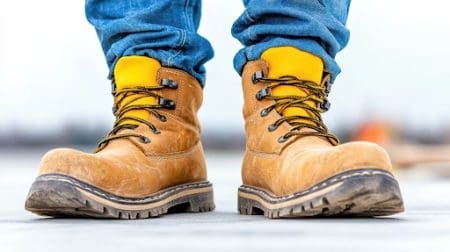
Construction Safety Matters
Are You Wearing the Right Protective Footwear For the Job?
When it comes to preventing injuries and ensuring your health and safety on the job, personal protective equipment (PPE) is your first and most crucial line of defense. However, one often overlooked type of PPE is safety footwear, which is designed to protect your feet from common construction zone hazards.
Depending on the job activity and equipment you use, the following exposures could lead to serious foot injuries:
- Heavy objects, which could fall or roll onto your feet
- Sharp objects, which could puncture your feet
- Corrosive materials
- Electrical hazards
- Hot or slippery surfaces
When these risks are present in the workplace, employees must wear protective footwear to ensure safety and reduce injury risks. While you may think that a pair of boots is all you need to avoid injury, there are a number of different hazards that a regular work boot may not protect against. In this blog, we examine the most common types of safety boots so you can find your perfect fit.
Why the Right Safety Boots are Essential
Several factors determine what type of footwear is appropriate for you, including the potential hazards you’re exposed to, the machinery you use and the requirements of your position. What’s more, there are different types of safety boots, each designed to mitigate specific workplace hazards. That’s why finding the right kind is essential for ensuring your safety. The following are the most common forms of protective footwear:
- Steel-toe, reinforced safety-toe or reinforced toecap boots: These boots are designed to protect against crushing injuries caused by falling or dropped objects. For extra protection, metatarsal guards can be used, which help to safeguard the bones between your toes and ankle.
- Puncture-resistant boots: Typically reinforced with metal, these boots are designed to prevent injury should you step on a nail, screw or other sharp object.
- Metal-free footwear: These boots are nonconductive and protect against electrocution risks. In general, they provide protection for up to 600 volts of electricity in dry environments.
- Slip-resistant boots: This type of boot is equipped with a specialized sole that can reduce slip, trip and fall risks. You’ll most often find these in shop environments where cords, materials and other items increase trip hazards.
- Insulated footwear: These boots are designed to protect feet against extreme temperatures. It should be noted that there are specific boots for both hot and cold environments. Furthermore, risks related to chemical burns require specially treated boots.
Regardless of the type of safety boots you use, it’s important to ensure they fit properly and are well maintained. Safety boots should be inspected before each use for signs of wear. If a boot is cracked or shows other signs of damage, replace it immediately.
Talk to a Construction Safety Leader
To learn more about protective footwear, consult with the construction safety and risk management experts at VTC Insurance Group. We’re committed to helping construction companies maintain a safe work environment. You can reach us at 248.828.3377 or visit vtcins.com.
This blog is for informational purposes only and is not intended as legal advice.


